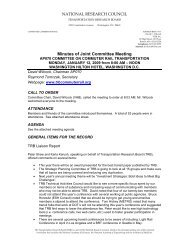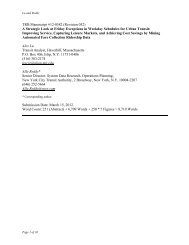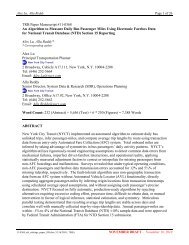Measuring & Controlling Subway Fare Evasion ... - Lexciestuff.net
Measuring & Controlling Subway Fare Evasion ... - Lexciestuff.net
Measuring & Controlling Subway Fare Evasion ... - Lexciestuff.net
You also want an ePaper? Increase the reach of your titles
YUMPU automatically turns print PDFs into web optimized ePapers that Google loves.
<strong>Measuring</strong> &<br />
<strong>Controlling</strong><br />
<strong>Subway</strong> <strong>Fare</strong><br />
<strong>Evasion</strong>:<br />
Improving<br />
NYCT’s Safety<br />
and Security<br />
Alla Reddy, Jacqueline Kuhls,<br />
and Alex Lu<br />
Operations Planning<br />
Office of Management & Budget<br />
New York City Transit Authority<br />
Presented at the 90 th Annual Meeting of the<br />
Transportation Research Board<br />
Washington D.C. (2011)<br />
T R A N S I T<br />
Photo: NYC Transit DRAW<br />
Notice: Opinions expressed in this presentation are those of the authors and do not necessarily reflect the official<br />
New<br />
New<br />
York<br />
York<br />
City<br />
City<br />
Transit<br />
Transit policy or position of Metropolitan Transportation Authority or MTA New York TRB City Transit. Paper #11-2016 Slide 1
Background<br />
Photo: NYC Transit DRAW<br />
• <strong>Fare</strong> evasion measured<br />
by station agents since<br />
early 1990s<br />
• Reduced from 6.9% to<br />
supposedly about 0.2%<br />
because of:<br />
– New AFC system<br />
– Graffiti control<br />
– Police patrols<br />
– Civil penalties<br />
– General crime reduction<br />
• Renewed concerns:<br />
– Booth destaffing program<br />
– <strong>Fare</strong> increases<br />
– ‘Panic bars’ on exit gates<br />
New York City Transit TRB Paper #11-2016 Slide 2
<strong>Fare</strong> Collection Hardware<br />
Photos: NYC Transit DRAW<br />
Booth<br />
(Full Time & Part Time)<br />
HEETs<br />
HXT<br />
(Not surveyed)<br />
Painted HXT<br />
(Not surveyed)<br />
New York City Transit TRB Paper #11-2016 Slide 3
<strong>Fare</strong> Tariff & Defining <strong>Evasion</strong><br />
• Official methods:<br />
– Children under 44”<br />
• Must crawl under turnstile<br />
• Not allowed alone<br />
– Passengers with bulk items,<br />
school field trips<br />
• Request agent assistance<br />
• Enter through gate<br />
– ‘Block’ or half-fare tickets<br />
• Surrender paper ticket<br />
• Enter through special entry<br />
turnstile<br />
• Unofficially:<br />
– Riders open gates for paid<br />
passengers with bulk items<br />
– Children squeeze through<br />
high-wheels with paid adults<br />
– Flash passes, uniforms,<br />
contractors go through gates<br />
New York City Transit TRB Paper #11-2016 Slide 4
Under<br />
Turnstile <strong>Fare</strong> <strong>Evasion</strong> Methods<br />
Bump<br />
Photos: NYC Transit PID<br />
Camera Footage<br />
Over<br />
Backcock<br />
New York City Transit TRB Paper #11-2016 Slide 5
Deliberate<br />
Gate <strong>Fare</strong> <strong>Evasion</strong> Methods<br />
Photos: NYC Transit PID<br />
Camera Footage<br />
Opportunistic<br />
1 2<br />
Backcocks, then use panic bar to open gate<br />
Gate Left Open<br />
Catches gate to enter after others exit<br />
Questionable<br />
Opens unlocked gate to enter, or gate ajar<br />
1 2<br />
Police opens gate for stroller, bystander enters<br />
New York City Transit TRB Paper #11-2016 Slide 6
Observation Methodology<br />
<strong>Evasion</strong>s Questionable Legal Entries<br />
Traditional Turnstile<br />
• Under (over 44”)<br />
• Jump<br />
• Backcock<br />
• Bump<br />
(a) Low TS<br />
(b) HEET<br />
Gate (Panic Bar)<br />
• Opportunistic<br />
• Deliberate<br />
• Gate Left Open<br />
Tracked<br />
• School Group<br />
• Police/Fire/Court:<br />
(a) Badge<br />
(b) Uniform<br />
• Flash Pass<br />
• Open Gate with Key:<br />
(a) TA key<br />
(b) Emergency key<br />
• “Other”<br />
Not Tracked<br />
• Selling ‘Swipes’<br />
• MetroCard passback<br />
• Normal Turnstile<br />
Entry<br />
• Normal HEET Entry<br />
• Child under 44”, with<br />
fare-paying adult<br />
• Paper Ticket<br />
• Bulk Item<br />
• Discreet observations in half-hour periods divided into six-minute<br />
blocks; stratified sample (income and throughput); capture<br />
unusual activity only. Entries recorded in one of 19 categories.<br />
New York City Transit TRB Paper #11-2016 Slide 7
Data Collection Forms<br />
New York City Transit<br />
TRB Paper #11-2016 Slide 8
<strong>Subway</strong> <strong>Fare</strong><br />
<strong>Evasion</strong> Trends<br />
• Systemwide: 1.3%<br />
• By time period:<br />
– Peak periods: ~0.9%<br />
• more evasions per hour<br />
• but lower rates per passenger<br />
– Midday and nights: 1.3%~1.9%<br />
• high evasion rates<br />
• but not many evaders<br />
– School hour: almost 3.0%<br />
• highest evasions per psgr<br />
• By system entry rate:<br />
– Busy stations: ~0.5%<br />
• low per-passenger rates<br />
• high per-hour rates (8.0 /hr)<br />
– Quiet stations: up to 5.5%<br />
• high per-passenger rates<br />
• low per-hour rates (
<strong>Evasion</strong> Trends:<br />
Income & Season<br />
• By median income<br />
– Higher evasions observed in<br />
stations where adjacent census<br />
tract median income < $30k<br />
– No effect when income > $30k<br />
<strong>Fare</strong> <strong>Evasion</strong> Rate (per Psgr)<br />
2.5%<br />
2.0%<br />
1.5%<br />
1.0%<br />
0.5%<br />
0.0%<br />
Weekday <strong>Evasion</strong> by Median Income<br />
6~18<br />
18~24<br />
24~28<br />
28~32<br />
32~36<br />
36~42<br />
42~48<br />
48~62<br />
62~70<br />
70~86<br />
86~176<br />
Station Median Income Range ($ Thousands)<br />
* Ex cludes afternoon school<br />
discharge hour (15:00-15:59)<br />
Ev asion per Psgr<br />
Ev asion per Hour<br />
Sample size = 167,817 entries<br />
8.0<br />
7.0<br />
6.0<br />
5.0<br />
4.0<br />
3.0<br />
2.0<br />
1.0<br />
0.0<br />
<strong>Fare</strong> <strong>Evasion</strong> Rate (per Hour)<br />
• Seasonality<br />
– <strong>Evasion</strong> is more prevalent<br />
during warm summer months<br />
• Summer = ~1.7%<br />
Winter = ~0.9%<br />
• Consistent with literature on<br />
general crime trends<br />
• Seasonal ridership impacts<br />
(trip purpose)<br />
<strong>Fare</strong> <strong>Evasion</strong> Rate (per Psgr)<br />
2.0%<br />
Ev asion per Psgr<br />
1.8%<br />
Ev asion per Hour<br />
1.6%<br />
1.4%<br />
1.2%<br />
1.0%<br />
0.8%<br />
0.6%<br />
0.4%<br />
0.2%<br />
0.0%<br />
09/04~09/06<br />
09/05~09/07<br />
09/06~09/08<br />
09/07~09/09<br />
09/08~09/10<br />
09/09~09/11<br />
Reporting Period (Rolling Average)<br />
Seasonality of <strong>Fare</strong> <strong>Evasion</strong><br />
09/10~09/12<br />
09/11~10/01<br />
09/12~10/02<br />
10/01~10/03<br />
10/02~10/04<br />
10/03~10/05<br />
10/04~10/06<br />
10/05~10/07<br />
10/06~10/08<br />
8.0<br />
7.0<br />
6.0<br />
5.0<br />
4.0<br />
3.0<br />
2.0<br />
1.0<br />
0.0<br />
<strong>Fare</strong> <strong>Evasion</strong> Rate (per Hour)<br />
Sample size = 37,269 entries per period<br />
New York City Transit TRB Paper #11-2016 Slide 10
Combating <strong>Fare</strong> <strong>Evasion</strong><br />
Photo: NYC Transit DRAW<br />
• Properly locking service<br />
access gates at all times<br />
• Improve communication of<br />
child height restrictions<br />
• <strong>Fare</strong> control configuration<br />
and staff presence don’t<br />
seem to have much effect<br />
– Gate evasion rates:<br />
0.9% unstaffed, 1.0% staffed<br />
– High-wheel evasion rates:<br />
1.2% unstaffed, 1.0% staffed<br />
• Tackling organized fare<br />
abuse operations (swipers)<br />
– Vending machine vandalism<br />
costs repair expenses<br />
– Swiping impacts revenue<br />
– Work with NYPD Transit<br />
Bureau and community courts<br />
– Use video evidence if available<br />
New York City Transit TRB Paper #11-2016 Slide 11
<strong>Fare</strong> Enforcement Issues<br />
• Legal framework<br />
– New York’s rules were well<br />
established by the 1980s<br />
– Important clarifications:<br />
• arrest versus summons<br />
• undercover enforcement<br />
permissible?<br />
• arresting powers<br />
• dispute/appeals process<br />
– Expected fines versus fares<br />
• New York’s fine = $100<br />
• progressive?<br />
• “street economics”<br />
• “Surge” enforcement<br />
• Video recording cameras<br />
– Shared use for anti-terrorism<br />
New York City Transit TRB Paper #11-2016 Slide 12
Public Relations<br />
New York City Transit Reprinted with permission © 2010 New York Daily News. TRB Paper #11-2016 Slide 13
Conclusions & Future Work<br />
• Multi-pronged approach is<br />
required to manage evasion<br />
– AFC security & audit features<br />
– Legal enforcement framework<br />
– Data collection & analysis to<br />
identify ‘hot spots’<br />
– Task-force based approach<br />
– Comprehensive press strategy<br />
• Information sharing is key<br />
– Crime of opportunity<br />
– Controls are necessary<br />
• Future work<br />
– Measurable benefits of fare<br />
enforcement<br />
– Evader-criminal correlation<br />
– Countermeasure effectiveness<br />
– Socio-demographic patterns<br />
Photo: NYC Transit DRAW<br />
New York City Transit TRB Paper #11-2016 Slide 14
Acknowledgements<br />
• Ben Lonner, Kishor<br />
Sharma, Justin Serina<br />
– MTA Audit Services<br />
• Raymond Diaz, Edward<br />
O’Brien, Jim Donovan<br />
– NYPD Transit Bureau<br />
• NYCT Colleagues in<br />
– System Data & Research<br />
– Automated <strong>Fare</strong> Collection<br />
– Office of Management &<br />
Budget<br />
• TRB AP030 Committee’s<br />
Anonymous Reviewers<br />
Photo: Amanda Marsh<br />
Notice: Opinions expressed in this presentation are those of the authors and do not necessarily reflect the official<br />
New<br />
New<br />
York<br />
York<br />
City<br />
City<br />
Transit<br />
Transit policy or position of Metropolitan Transportation Authority or MTA New York TRB City Transit. Paper #11-2016 Slide 15







